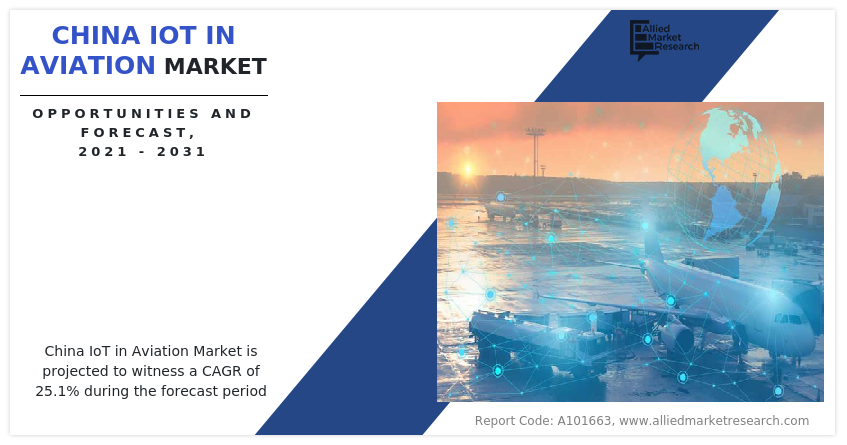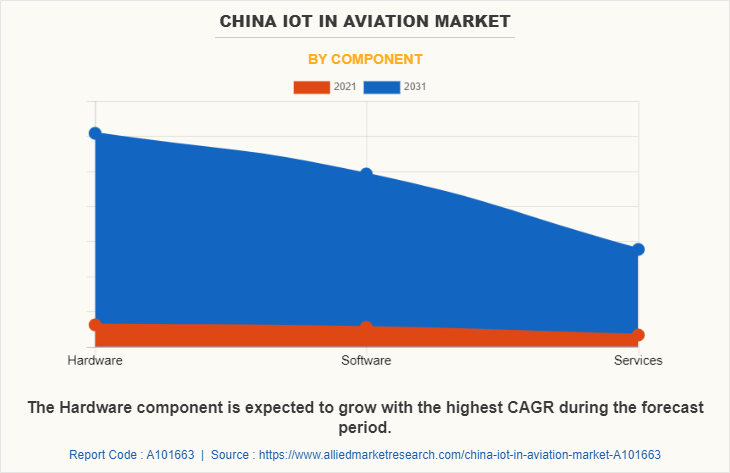The China IoT in aviation market has experienced significant growth owing to several factors. One of the major drivers includes relentless pursuit of efficiency and safety. Various stakeholders in the industry, including airlines, airports, maintenance, repair, & overhaul (MRO) organizations, and manufacturers, are actively searching for ways to improve their operational efficiency, cut down on expenses, and prioritize the safety of their aircraft and passengers. In addition, implementation of IoT technologies allows for the real-time monitoring of crucial systems, predictive maintenance, and data-driven decision-making, all of which play a crucial role in achieving these goals.

On the other hand, the market's trajectory has been influenced by certain limitations. The utmost importance is placed on concerns regarding data security and privacy. As the aviation industry receives an abundance of data from different sources, it faces the challenge of protecting sensitive information from cyber threats. Moreover, significant initial investment needed for IoT implementation discourages certain participants. It is imperative to overcome these obstacles to ensure the market's sustained expansion.
However, the market offers a complex array of opportunities. Its applications span a wide range, including ground operations, passenger experience, asset management, and air traffic management. Real-time monitoring of equipment and facilities greatly improves the efficiency of ground operations by optimizing workflows. Passengers have a more personalized and interconnected experience, due to IoT's enhancements in in-flight entertainment, connectivity, and services. Furthermore, asset management becomes more streamlined through the implementation of predictive maintenance and tracking systems, while air traffic management optimizes routes and alleviates congestion.

The China IoT in aviation market is segmented into component, end user, and application. Further, on the basis of component, the market is classified into hardware, software, and services. Hardware constitutes sensors, devices, and communication equipment, serving as the foundation of IoT systems. Software encompasses platforms and applications responsible for interpreting and managing the collected data. In addition, services encompass a wide range of offerings, including consulting, system integration, support, and maintenance. By end user, it is segregated into airline, airport, MROs, and manufacturers. Depending on application, the market is fragmented into ground operations, passenger experience, asset management, and air traffic management.
Companies in the aviation sector are continuously working toward developing advanced IoT solutions that cater to their unique requirements. These solutions involve integration of cutting-edge technologies such as AI, edge computing, and blockchain. The market's R&D efforts are unwavering, as companies strive to understand the evolving needs of airlines, airports, MROs, and manufacturers. By doing so, they introduce solutions that effectively anticipate and address the challenges faced by these entities.
By End User
The Airport end user is expected to grow with the highest CAGR during the forecast period.
The market is heavily influenced by the perceptions of consumers and end users. Airlines and airports are compelled to invest in IoT solutions that improve the passenger experience, as passengers demand a seamless and connected journey. The feedback and preferences of consumers are crucial for refining and enhancing IoT applications. Moreover, pricing strategies in this market are dynamic and often flexible, with companies tailoring costs to the specific needs and scale of their clients. Subscription-based services are frequently offered to ensure a steady revenue stream and ongoing support.
By Application
The Passenger Experience type is expected to grow with the highest CAGR during the forecast period.
The Porter’s five forces analysis analyzes the competitive scenario of the China IoT in aviation market and role of each stakeholder. These forces include the bargaining power of suppliers, bargaining power of buyers, threat of substitutes, threat of new entrants, and competitive rivalry. The threat of new entrants in the market is minimal due to substantial financial investment and specialized expertise required for the development and implementation of IoT solutions. Although the bargaining power of suppliers in this market varies, it generally remains moderate. While there are multiple suppliers offering IoT hardware, software, and services, the aviation industry's need for customization and adherence to regulations limit the number of suitable suppliers for large-scale projects.
The bargaining power of buyers is significant, as airlines, airports, MROs, and manufacturers have a wide array of options when choosing IoT solution providers. The quality and cost-effectiveness of these solutions play a crucial role in their decision-making process. The threat of substitutes is relatively low, as IoT solutions have become increasingly essential to aviation operations. Reverting to traditional methods would result in decreased efficiency and higher costs. The level of competitive rivalry is intense, with numerous companies competing for a share of the aviation IoT market. Both established players and new entrants continuously strive to innovate and gain a competitive advantage, resulting in a dynamic and fiercely competitive landscape.
Key players operating in the market are Huawei Technologies Co., Ltd., China Telecom Corporation Limited, China Mobile Communications Corporation, China Unicom (Hong Kong) Limited, Tencent Holdings Limited, Alibaba Group Holding Limited, Baidu, Inc., ZTE Corporation, Comac (Commercial Aircraft Corporation of China, Ltd.), and Air China Limited.
Key Benefits For Stakeholders
- Enable informed decision-making process and offer market analysis based on the current market situation and estimated future trends.
- Analyze the key strategies adopted by major market players in China's IoT aviation market.
- Assess and rank the top factors that are expected to affect the growth of China's IoT aviation market.
- Top Player positioning provides a clear understanding of the present position of market players.
- Detailed analysis of the China IoT in aviation market segmentation assists to determine the prevailing market opportunities.
- Identify key investment pockets for various offerings in the market.
China IoT in Aviation Market Report Highlights
| Aspects | Details |
| Forecast period | 2021 - 2031 |
| Report Pages | 70 |
| By Component |
|
| By End User |
|
| By Application |
|
| Key Market Players | Commercial Aircraft Corporation of China (COMAC), China Airport Group, AVIC International Holding Corporation, Boeing 787 Dreamliner, Airbus A350XWB-China, Hangzhou EastStar General Aviation, Internet of Aviation (IoA), China Smart Airspace System (CSAS), SITA’s Airport IoT Connect, China International Aviation and Aerospace Exhibition (CAEA) |
The China IoT in Aviation Market is projected to grow at a CAGR of 25.1% from 2021 to 2031
Airbus A350XWB-China, China Airport Group, Boeing 787 Dreamliner, China Smart Airspace System (CSAS), Hangzhou EastStar General Aviation, Commercial Aircraft Corporation of China (COMAC), Internet of Aviation (IoA), SITA’s Airport IoT Connect, China International Aviation and Aerospace Exhibition (CAEA), AVIC International Holding Corporation are the leading players in China IoT in Aviation Market
1. Enable informed decision-making process and offer market analysis based on current market situation and estimated future trends.
2. Analyze the key strategies adopted by major market players in china iot in aviation market.
3. Assess and rank the top factors that are expected to affect the growth of china iot in aviation market.
4. Top Player positioning provides a clear understanding of the present position of market players.
5. Detailed analysis of the china iot in aviation market segmentation assists to determine the prevailing market opportunities.
6. Identify key investment pockets for various offerings in the market.
China IoT in Aviation Market is classified as by component, by end user, by application
Loading Table Of Content...
Loading Research Methodology...



